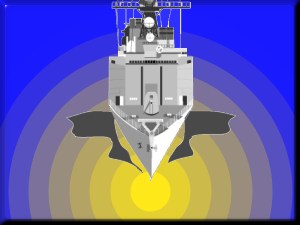
From Draft NOtices, April - June 2006Militarism Kills Whales— Mernie Aste |

|
|||
The struggle to keep the Navy from wreaking havoc on ocean mammals continues. As recently as January 30, 2006, the National Oceanic and Atmospheric Administration has written a formal comment in response to the Navy’s draft environmental statement proposing a 500-square nautical mile range to be used for sonar testing about 40 miles east of North Carolina. The missive warns that the Navy significantly underestimated the danger posed to whales and other marine mammals and used flawed science to reach its conclusions in a report on the use of the site for training sailors to detect foreign submarines that come near U.S. shores. In its own statement, even the Navy concluded that the species most likely to be found in this site off North Carolina include fin, humpback and right whales, all of which are endangered, as well as sperm, pygmy and beaked whales, according to PilotOnline.com. This is an issue familiar to environmentalists on the West Coast. On October 19, 2005, the Natural Resources Defense Council (NRDC), other environmental groups and Jacques Cousteau's son, Jean-Michel Cousteau, filed a lawsuit in U.S. District Court in Los Angeles. The suit presented evidence that the most widely used form of sonar disturbs and kills whales and dolphins. Environmentalists cited several incidents since the 1980s in which whales died around the time mid-frequency active sonar training was taking place. NRDC claims that some whales exposed to the sonar signals have been found bleeding from the eyes and ears. The Humane Society of the United States, the League for Coastal Protection and the Cetacean Society International were also plaintiffs in the suit, along with the nation’s Marine Fisheries Service. The goal of the lawsuit was to limit the use of sonar in Navy training exercises. Two years previously, a group of environmentalists settled a federal lawsuit involving the Navy's use of low-frequency sonar. As part of the deal, the Navy was to employ its low-frequency sonar system only for testing and training in the northwest Pacific Ocean. The problem is not limited to the U.S. military. According to the March 20, 2006, issue of The Independent (online edition), “Secret sonar, used by the Royal Navy in a NATO exercise, has killed four whales. . . . A post-mortem on four Cuvier's beaked whales, stranded on Spain's Almeira coast at the end of January, points to the sonar, which was being used by a British warship in the area at the time. It is the first time that the Royal Navy has been implicated in whale deaths.” Nationalgeographic.com reported in March 2004 on the disturbing behavior of orcas, Dalle’s porpoises and minke whales in Puget Sound. At the time of this incident (May 2003), “strange underwater pinging noises were detected with underwater microphones. The sound originated from a U.S. Navy frigate 12 miles (19 kilometers) distant using sonar. The vessel eventually moved within 4 miles (6.4 kilometers) of Puget Sound. In the following weeks an above-average number of seemingly healthy porpoises were found stranded on nearby beaches.” This issue has been widely reported since March of 2000 when a U.S. Navy battle group used sonar in the area of the Bahamas. Shortly afterwards, four different species of whales stranded themselves on beaches and they were found to have been bleeding internally around their brains and ears. Exemptions from environmental laws are granted regularly by Congress. In spite of the extensive evidence of the damage to marine life, the Navy continues to use national security as a justification to obtain exemptions to the Marine Animal Protection Act, the Migratory Bird Act, the Clean Air Act, the Solid Waste Disposal Act, and the Comprehensive Environmental Response Compensation and Liability Act. The culture of militarism is in clear contradiction with the responsibility each of us has to share our planet’s resources fairly among all its inhabitants. The Navy’s use of low-frequency active sonar is but one graphic example of how this culture clashes with the values of people who strive to maintain the Earth’s delicate and precious web of life. Information sources: http://home.hamptonroads.com/stories/story.cfm?story=95850&ran=139018 This article is from Draft NOtices, the newsletter of the Committee Opposed to Militarism and the Draft (http://www.comdsd.org) |
||||